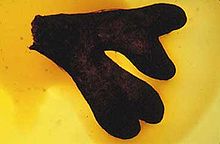 The cladoxylopsids are a group of plants known only as fossils that are thought to be ancestors of ferns and horsetails.
The cladoxylopsids are a group of plants known only as fossils that are thought to be ancestors of ferns and horsetails.They had a central trunk, from the top of which several lateral branches were attached. Fossils of these plants originate in the Middle Devonian to Early Carboniferous periods (around 390 to 320 million years ago), mostly just as stems.
Cladoxylopsida contains two orders. The order Hyeniales is now included in Pseudosporochnales.
Intact fossils of the Middle Devonian cladoxylopsid Wattieza show it to have been a tree, the earliest identified in the fossil record as of 2007.
In Paleorrota geopark in Rio Grande do Sul, Brazil, were found Gangamopteris obovata. Were located on the Mina Morro do Papaléo in Mariana Pimentel and Quitéria in Pantano Grande. Dating from the Permian and were in the Rio Bonito Formation. In the town of Cachoeira do Sul, met Gangamopteris sulriograndensis were discovered.
 Protosalvinia is a prehistoric plant found commonly in shale from shoreline habitats of the Upper Devonian period. The name Protosalvinia is a misnomer. The name literally means early Salvinia, and was given in the erroneous belief that the fossils were an earlier form of the living aquatic fern Salvinia. It is no longer believed that the fossils come from a fern, but deciding exactly what the fossils represent is still a matter of debate. This is surprising when one considers how much is known about the fossils.
Protosalvinia is a prehistoric plant found commonly in shale from shoreline habitats of the Upper Devonian period. The name Protosalvinia is a misnomer. The name literally means early Salvinia, and was given in the erroneous belief that the fossils were an earlier form of the living aquatic fern Salvinia. It is no longer believed that the fossils come from a fern, but deciding exactly what the fossils represent is still a matter of debate. This is surprising when one considers how much is known about the fossils.The most likely interpretation of Protosalvinia is that it represents either a fossil liverwort or brown alga, although no definitive brown algae have been identified from before the Tertiary period, and examination of the spore structure shows no features in common with living groups of brown algae. The living plant was a thallus with short dichotomous branching. The branches in the largest species were as much as one centimeter across. In some fossils, the branching lobes lie flat, but in others the tips of the branches are curled up over the fossil, giving it a round outline. Embedded in the tissues of the thallus are chambers in which spores (200 micrometre diameter) were produced by meiosis.
Because Protosalvinia is usually preserved as a compression fossil, it can be difficult to determine whether its anatomy is more like a plant or an algae. Some biochemical evidence favors interpretation as an algae. Lignin and Cutin have been found in the thalli, and sporopollenin in the spore walls. The grouping of the spores found in the thallus favors interpretation as a plant. The absence of any stomata on the surface is inconclusive, as all bryophytes lack stomata on the main body of the plant.
However, the tips of Protosalvinia branches show evidence of conceptacle-like dips.
Protosalvinia is found in association with conodont elements.
For the present, the relationships of Protosalvinia remain uncertain. SOURCE:WIKIPEDIA

No comments:
Post a Comment